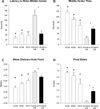Ontogeny and adolescent alcohol exposure in Wistar rats: open field conflict, light/dark box and forced swim test
- PMID: 24785000
- PMCID: PMC4105136
- DOI: 10.1016/j.pbb.2014.04.011
Ontogeny and adolescent alcohol exposure in Wistar rats: open field conflict, light/dark box and forced swim test
Abstract
Epidemiological studies have demonstrated that heavy drinking and alcohol abuse and dependence peak during the transition between late adolescence and early adulthood. Studies in animal models have demonstrated that alcohol exposure during adolescence can cause a modification in some aspects of behavioral development, causing the "adolescent phenotype" to be retained into adulthood. However, the "adolescent phenotype" has not been studied for a number of behavioral tests. The objective of the present study was to investigate the ontogeny of behaviors over adolescence/young adulthood in the light/dark box, open field conflict and forced swim test in male Wistar rats. These data were compared to previously published data from rats that received intermittent alcohol vapor exposure during adolescence (AIE) to test whether they retained the "adolescent phenotype" in these behavioral tests. Three age groups of rats were tested (post-natal day (PD) 34-42; PD55-63; PD69-77). In the light/dark box test, younger rats escaped the light box faster than older adults, whereas AIE rats returned to the light box faster and exhibited more rears in the light than controls. In the open field conflict test, both younger and AIE rats had shorter times to first enter the center, spent more time in the center of the field, were closer to the food, and consumed more food than controls. In the forced swim test no clear developmental pattern emerged. The results of the light/dark box and the forced swim test do not support the hypothesis that adolescent ethanol vapor exposure can "lock-in" all adolescent phenotypes. However, data from the open field conflict test suggest that the adolescent and the AIE rats both engaged in more "disinhibited" and food motivated behaviors. These data suggest that, in some behavioral tests, AIE may result in a similar form of behavioral disinhibition to what is seen in adolescence.
Keywords: Adolescence; Anxiety; Depression; Disinhibition; Ethanol vapor.
Copyright © 2014. Published by Elsevier Inc.
Figures

References
-
- Bourin M, Hascoet M. The mouse light/dark box test. Eur. J Pharmacol. 2003;463:55–65. - PubMed
-
- Clark DB, Thatcher DL, Tapert SF. Alcohol, psychological dysregulation, and adolescent brain development. Alcohol Clin. Exp. Res. 2008;32:375–385. - PubMed
-
- Dahl RE, Spear LP. Adolescent brain development: Vulnerabilities and opportunities. New York, N.Y: The New York Academy of Sciences. 2004 - PubMed
Publication types
MeSH terms
Substances
Grants and funding
LinkOut - more resources
Full Text Sources
Other Literature Sources

